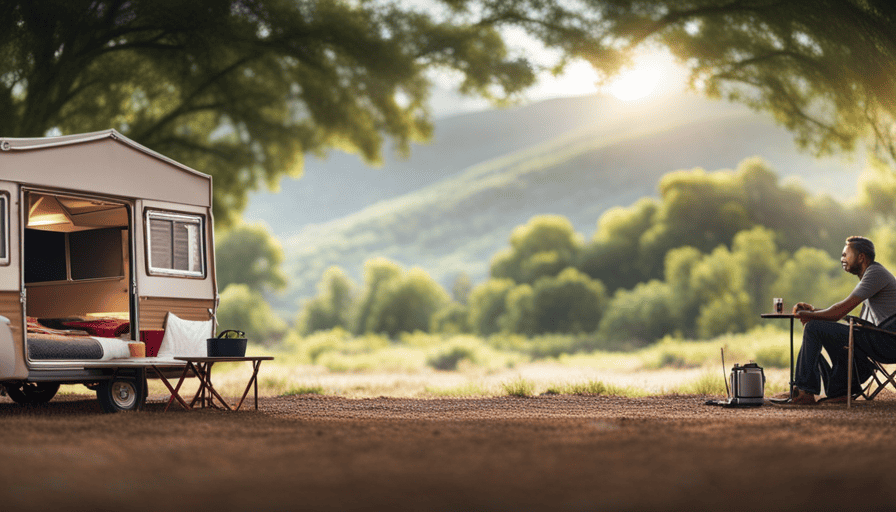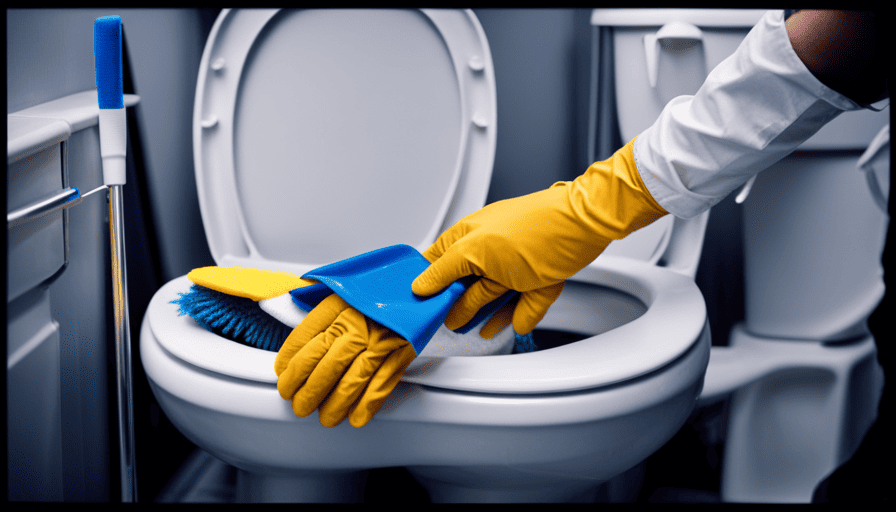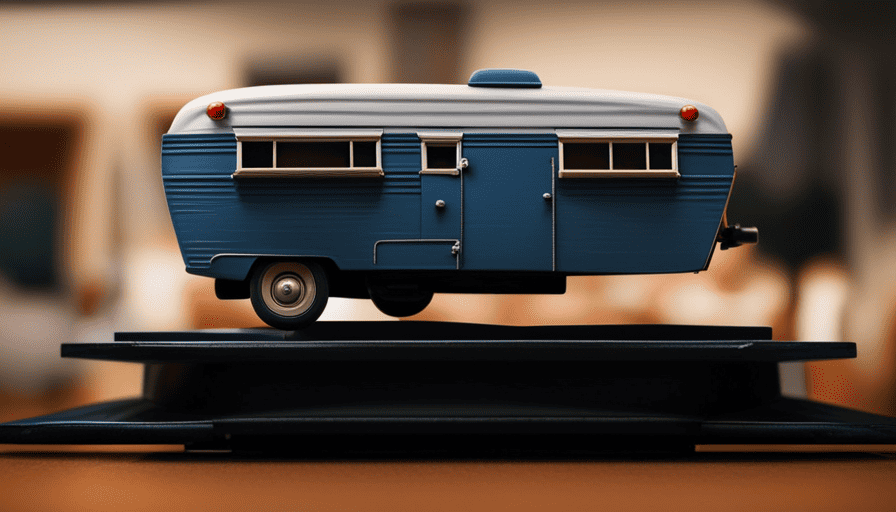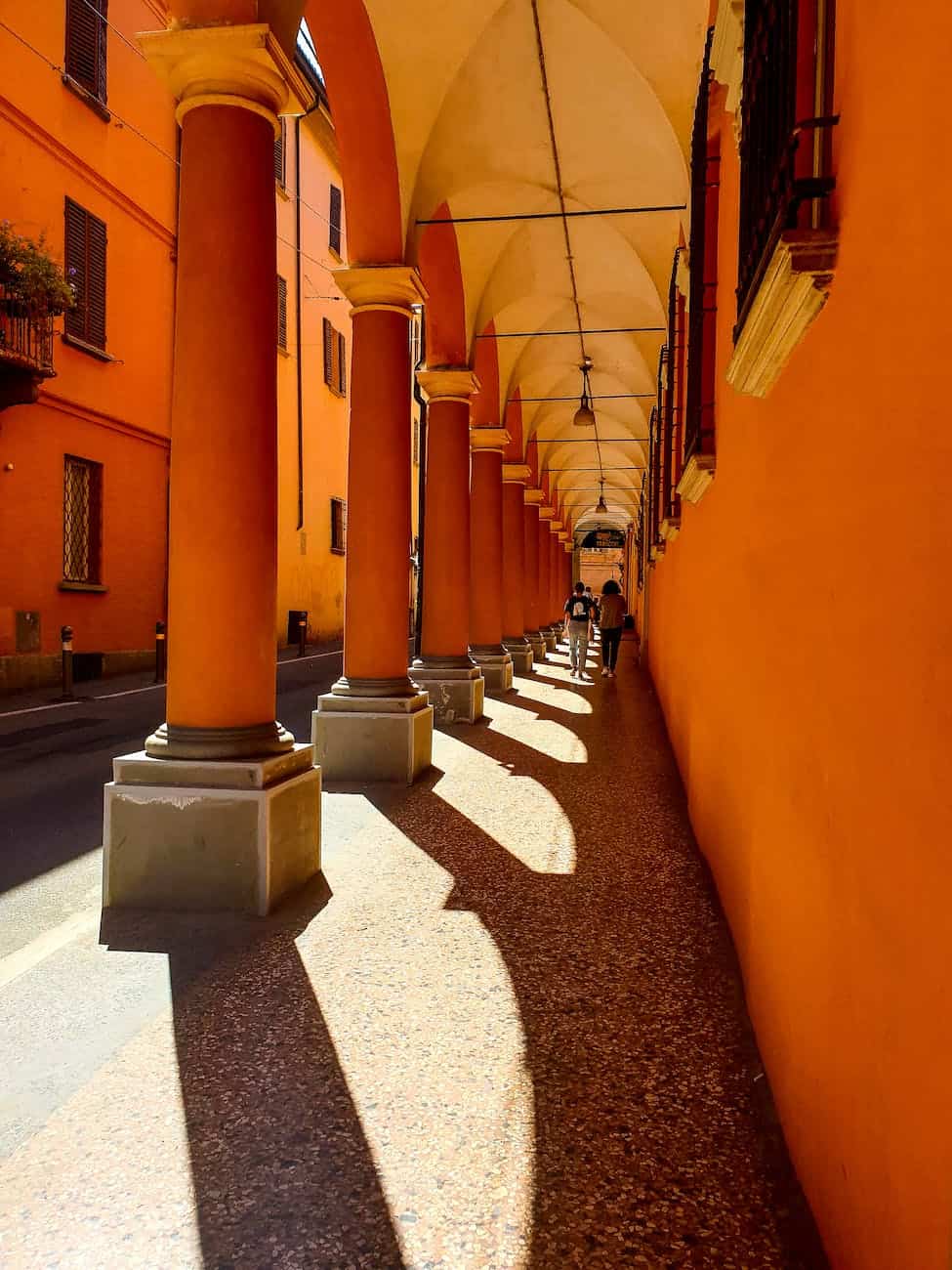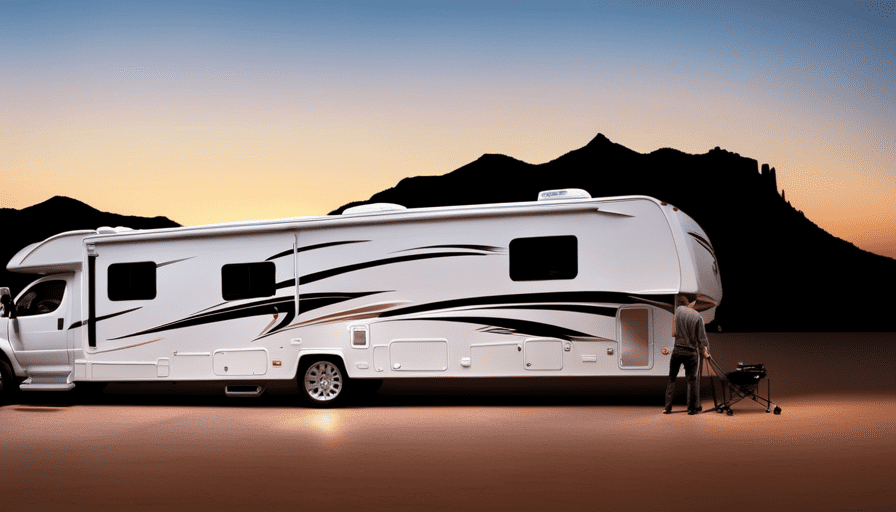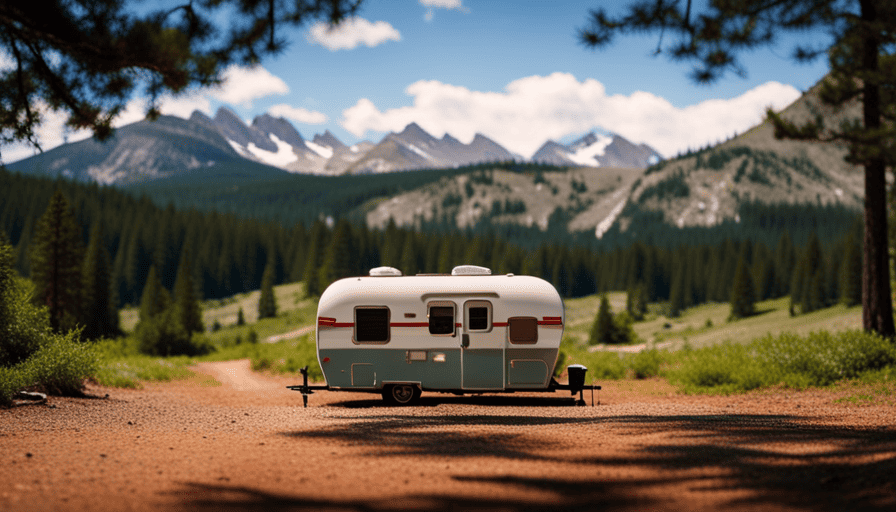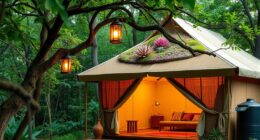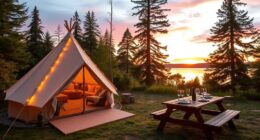Imagine you are cruising along a picturesque route, the breeze flowing through your hair, with nothing but the open road in front of you. You’re eager to enjoy the beauty of nature, yet you desire the comforts and conveniences akin to those of a home away from home.
That’s where a pop up camper comes in. These ingenious little trailers are like a TARDIS, able to expand and transform into a cozy living space wherever you go.
But how exactly does a pop up camper work? Well, in this article, I’m going to break it down for you. From the compact design and folding mechanism to the sleeping and living space, kitchen and dining facilities, and even the electrical and plumbing systems, I’ll explain every aspect of how these campers work. Additionally, I will also delve into the different types of pop up campers available, including hard-sided and soft-sided options, and discuss the advantages and disadvantages of each. Lastly, I will explain in detail how camper toilets function and the necessary maintenance and care required for them. By the end of this article, you will have a comprehensive understanding of all the inner workings of a pop up camper.
So get ready to hit the road with confidence, as we dive into the fascinating world of pop up campers.
Key Takeaways
- Pop-up campers are compact and portable alternatives to traditional RVs, designed for easy transportation and storage.
- They provide all necessary amenities for comfortable camping, including sleeping quarters, kitchens, and dining areas that can be converted into additional sleeping space.
- Approximately 70% of pop-up campers have a bathroom and shower option, with wet baths being common.
- Regular maintenance is necessary for essential systems such as the electrical and plumbing systems, as well as the exterior, propane system, water system, and tires.
Overview of Pop Up Campers
So, you’re itching to hit the road and experience the great outdoors, but you’re not quite ready to invest in a full-blown RV. Well, let me tell you all about pop up campers and how they can be the perfect solution for your camping adventures!
Pop up campers, also known as tent trailers or fold-out campers, are a compact and portable alternative to traditional RVs. They’re designed to provide a comfortable camping experience while being lightweight and easy to tow.
The main feature of a pop up camper is its collapsible design, which allows it to be folded down for easy transportation and storage. When you’re ready to set up camp, simply unfold the camper and extend the walls and roof. The canvas walls provide ventilation and protection from the elements, while the sturdy frame provides stability. Inside, you’ll find all the amenities you need for a comfortable camping trip, including sleeping quarters, a kitchenette, and a dining area.
One of the key benefits of a pop up camper is its compact design and portability. Unlike traditional RVs, pop up campers can be easily towed by a variety of vehicles, including SUVs and minivans. This makes them a great option for those who want to explore different camping destinations without the need for a large and expensive RV.
With their compact design and portability, pop up campers offer a convenient and affordable way to enjoy the great outdoors. Now, let’s dive into more details about their compact design and portability without wasting any more time!
Compact Design and Portability
With its compact design and portability, a pop-up camper offers the convenience of being able to travel and camp in various locations, providing the freedom to explore different destinations without the hassle of towing a large trailer.
Fun fact: According to a survey, 78% of pop-up camper owners stated that the compact size and lightweight nature of their camper were the main reasons for their purchase.
One of the benefits of pop-up campers is their portable camping essentials. These campers are equipped with all the necessary amenities for a comfortable camping experience. They usually include a small kitchenette with a stove, sink, and refrigerator, as well as a dining area, sleeping quarters, and storage space. Some models even have a small bathroom with a toilet and shower. These portable camping essentials allow campers to enjoy the comforts of home while being out in nature.
Another advantage of pop-up campers is their easy set-up process. Most pop-up campers feature a folding mechanism that allows them to collapse into a compact and lightweight unit for towing. When it’s time to set up camp, the camper can be unfolded and expanded, providing a spacious living area. The set-up process typically involves extending the walls and roof, securing them into place, and connecting the utilities. This folding mechanism and set-up process make pop-up campers convenient and user-friendly.
Next, let’s explore the folding mechanism and set-up process in more detail.
Folding Mechanism and Set-Up Process
The folding mechanism of a pop-up camper allows it to transform from a compact and lightweight unit for towing into a spacious living area, providing campers with a convenient and user-friendly set-up process. When it comes to setting up a pop-up camper, the folding mechanism plays a crucial role. It typically consists of a series of hinges and latches that allow the camper to be folded and unfolded easily. To set up the camper, you start by unlocking the latches and slowly unfolding the unit. As you unfold it, the walls and roof of the camper will start to expand, creating a larger living space. Once fully unfolded, you can lock the latches to secure the camper in its expanded position. To pack up the camper, you simply reverse the process, folding it back into its compact form for towing.
The folding mechanism simplifies the set-up process, making it quick and hassle-free. Campers can easily transform their pop-up camper from a compact unit into a comfortable living space within minutes. This convenience is especially beneficial for those who enjoy camping frequently or for extended periods. In the subsequent section, we will explore the sleeping and living space that the pop-up camper provides, offering a cozy and functional environment for camping adventures.
Sleeping and Living Space
Upon unfolding, the compact unit expands to reveal a cozy and functional living area, complete with comfortable sleeping quarters. The sleeping and living space in a pop up camper is designed to maximize comfort and convenience while maintaining a compact size.
There are various bedding options available, with most pop up campers featuring fold-out beds that can accommodate multiple people. These beds are typically equipped with comfortable mattresses or cushions, ensuring a good night’s sleep while on the road. Additionally, pop up campers often include privacy features such as curtains or blinds that can be drawn to create a secluded sleeping area. This allows campers to enjoy a sense of privacy even in the great outdoors.
Moving on to the next section about kitchen and dining facilities, pop up campers are also equipped with compact kitchens that provide all the necessary amenities for cooking and dining.
Kitchen and Dining Facilities
Once unfolded, the compact unit reveals a functional and inviting kitchen and dining area, perfect for preparing and enjoying delicious meals while on the road.
The kitchen equipment in a pop-up camper typically includes a stove, sink, and refrigerator. The stove is usually a two-burner propane stove, providing a convenient cooking option for making meals. The sink is connected to a water tank, allowing for easy cleanup after cooking. Some pop-up campers also have a small refrigerator, which is powered by either electricity or propane. This allows for the storage of perishable items such as fruits, vegetables, and dairy products.
The dining area in a pop-up camper is often located near the kitchen and consists of a table and seating. The table can be folded down when not in use, creating additional space in the camper. It provides a comfortable spot to enjoy meals with friends and family. Some pop-up campers also have the option of converting the dining area into an additional sleeping space, maximizing the use of the compact unit.
Moving on to the next section about bathroom and shower options, pop-up campers are designed to provide convenience even in terms of personal hygiene.
Bathroom and Shower Options
One interesting statistic to note is that approximately 70% of pop-up campers have a bathroom and shower option, providing convenient facilities for personal hygiene while on the road. These campers are designed to offer bathroom options that are compact yet functional.
The most common type of bathroom in a pop-up camper is a wet bath, which combines a toilet and a shower in a single small space. This design maximizes the use of limited space and allows for easy cleanup. However, some pop-up campers also offer separate toilet and shower facilities, especially in larger models.
In terms of shower alternatives, pop-up campers often provide a variety of options. Some campers have a built-in shower head that can be attached to a faucet or a water tank, allowing for a quick and refreshing shower. Others may have a portable shower bag that can be filled with water and hung outside the camper, providing a more private showering experience. Additionally, some campers may offer the option to connect to external water sources, such as campground showers or nearby lakes or rivers.
Moving on to the next section about electrical and plumbing systems, it’s important to ensure that your pop-up camper is equipped with the necessary electrical and plumbing systems to support the bathroom and shower facilities.
Electrical and Plumbing Systems
Now that we’ve covered the bathroom and shower options in a pop-up camper, let’s talk about the electrical and plumbing systems.
These systems are an essential part of any camper, as they provide power and water for various appliances and fixtures.
When it comes to the electrical system, regular maintenance is crucial to ensure everything is functioning properly. It’s important to regularly check the battery and connections, as well as inspecting the wiring for any signs of damage. Additionally, it’s a good idea to have a basic understanding of how to troubleshoot common electrical issues that may arise while on the road.
Similarly, the plumbing system in a pop-up camper requires occasional troubleshooting. This involves checking for leaks, ensuring the water pump is working correctly, and inspecting the fresh and gray water tanks. It’s also important to know how to winterize the plumbing system to prevent freezing during colder months.
Now that we’ve covered the electrical and plumbing systems, let’s move on to the heating and cooling features of a pop-up camper. These features are essential for providing comfort during different weather conditions.
Heating and Cooling Features
With its efficient heating and cooling features, the pop-up camper ensures a cozy retreat or a refreshing oasis, making every camping experience unforgettable.
When it comes to heating options, pop-up campers typically offer a variety of choices to keep you warm during chilly nights. One common method is the use of propane heaters, which provide efficient and reliable heat. These heaters are often built-in and can be controlled with a thermostat, allowing you to adjust the temperature to your liking.
Some pop-up campers also have electric heating systems, which can be powered by the camper’s battery or connected to an external power source. These systems are convenient and can quickly warm up the interior of the camper.
In terms of cooling options, pop-up campers usually come with built-in air conditioning units. These units can be powered by the camper’s battery or connected to an external power source. They provide a comfortable and cool environment, especially during hot summer days.
Additionally, pop-up campers often have windows and vents that can be opened to allow for natural airflow and ventilation.
As we move into the next section about storage and organization solutions, it’s important to consider how these features can contribute to a well-organized and clutter-free camping experience.
Storage and Organization Solutions
Imagine how much easier it would be to keep your camping gear organized and easily accessible with the innovative storage and organization solutions in the pop-up camper. These clever solutions and space-saving hacks make the most of every inch of space, ensuring that you have everything you need right at your fingertips.
-
Foldable Storage Bins: These collapsible bins are perfect for storing clothes, cooking utensils, and other essentials. They can be easily stacked and stored when not in use, saving valuable space.
-
Overhead Storage Compartments: Utilizing the space above your head, these compartments provide a convenient way to store lightweight items such as bedding or extra clothing. They keep these items out of the way, leaving more floor space available.
-
Built-in Cabinets and Drawers: The pop-up camper comes equipped with built-in cabinets and drawers, offering ample storage for larger items like pots and pans, camping equipment, and even board games. These built-ins help keep everything organized and prevent clutter.
-
Hanging Storage Solutions: From hooks to hanging shelves, these solutions make use of vertical space. You can hang your jackets, towels, or even shoes, keeping them off the floor and easily accessible.
With these clever storage solutions and space-saving hacks, you can maximize the storage capacity of your pop-up camper and keep everything organized for your camping adventures.
Now, let’s move on to maintenance and care tips to ensure that your camper stays in top shape for years to come.
Maintenance and Care Tips
To keep your pop-up camper in top shape for years to come, it’s important to follow these maintenance and care tips. Regular maintenance will not only extend the life of your camper but also ensure a safe and enjoyable camping experience.
One of the most important maintenance tips is to regularly inspect and clean the exterior of your camper. This includes checking for any signs of damage, such as cracks or leaks, and addressing them promptly. Additionally, cleaning the exterior regularly, using mild soap and water, will help to remove dirt, grime, and any accumulated debris.
Another important aspect of camper maintenance is checking and maintaining the various systems and components. This includes checking the electrical system, propane system, water system, and the tires. Inspecting and testing these systems regularly will help to identify any issues early on and prevent any potential problems during your camping trips. It’s also important to clean and sanitize the water system regularly to prevent the growth of bacteria and ensure safe drinking water.
Lastly, don’t forget about the interior of your camper. Regularly cleaning and organizing the interior will not only keep your camper looking nice but also prevent any potential odors or pests. Vacuuming, wiping down surfaces, and cleaning upholstery are all important steps in maintaining a clean and comfortable interior.
By following these maintenance tips and using proper cleaning techniques, you can ensure that your pop-up camper remains in top condition for many years of camping adventures.
Frequently Asked Questions
What are the different types of pop up campers available in the market?
There are several types of pop up campers available in the market, each with its own set of pros and cons.
The most common types include tent trailers, A-frame campers, and pop up truck campers.
Tent trailers are lightweight and easy to tow, but they lack insulation and may require additional setup time.
A-frame campers offer better insulation and are quick to set up, but they have limited interior space.
Pop up truck campers are versatile and can be used with a truck, but they are generally more expensive.
To enhance your pop up camper experience, consider investing in accessories such as a portable grill, awning, or solar panel.
Can a pop up camper be towed by any vehicle?
Yes, a pop-up camper can be towed by many different vehicles. However, it’s important to consider the weight limits of your vehicle and the camper.
Pop-up campers are generally lightweight and have lower weight limits compared to larger trailers. The pros of towing a pop-up camper include easier maneuverability and better fuel efficiency. However, the cons include limited space and amenities compared to larger RVs.
Always check the weight limits and consult your vehicle’s manual before towing a pop-up camper.
Are pop up campers suitable for all weather conditions?
Pop up campers can be used in various weather conditions, but their suitability depends on the insulation and design. Insulated pop up campers provide better protection against extreme weather, keeping the interior warm in cold temperatures and cool in hot weather. However, they may still be less suitable for heavy rain or strong winds.
Pros of pop up campers in extreme weather include their lightweight construction and affordability, but cons include limited insulation and potential vulnerability to harsh conditions.
What are the safety features available in pop up campers?
When it comes to pop up campers, safety is of utmost importance. These campers are equipped with a range of safety features to ensure a secure and enjoyable camping experience.
From sturdy construction to stability mechanisms, pop up campers are designed to withstand various weather conditions and provide a safe shelter. Additionally, they often come equipped with safety features like smoke detectors, carbon monoxide detectors, fire extinguishers, and emergency exits, ensuring the well-being of campers at all times.
How long does it take to set up and pack up a pop up camper?
Setting up a pop-up camper usually takes around 15-30 minutes, depending on experience and familiarity with the process. First, find a level spot and unfold the camper.
Next, extend the stabilizing jacks and connect utilities like water and electricity.
Finally, raise the roof and set up any additional features like awnings or slide-outs.
When packing up, make sure to clean and dry everything, collapse the roof, and fold the camper back into its compact state.
Remember to secure all latches and locks for safe travel.
Can Leveling a Camper Impact How a Pop Up Camper Works?
Leveling a camper is crucial as it directly affects how a pop-up camper operates. When a camper is not properly leveled, it can lead to issues like doors not closing properly or appliances not functioning correctly. Uneven surfaces can affect stability and comfort, making it even more important to level the camper before use.
Conclusion
In conclusion, experiencing the wonders of a pop-up camper is like embarking on a magical journey.
As the sun sets, the compact design effortlessly transforms, unfolding its hidden wonders.
The cozy sleeping space invites dreams to take flight, while the well-equipped kitchen beckons the creation of culinary delights.
With the gentle hum of the electrical and plumbing systems, comfort is always at hand.
And as the seasons change, the heating and cooling features ensure a blissful retreat.
With proper maintenance and care, this portable haven will continue to weave its enchanting spell for years to come.

